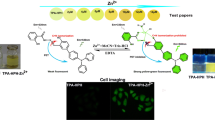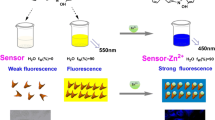Abstract
Selective fluorescence turn on Zn2+ sensor with long-wavelength emission and a large Stokes shift is highly desirable in Zn2+ sensing area. We reported herein the synthesis and Zn2+ recognition properties of a new thiosemicarbazone-based fluorescent sensor L. L displays high selectivity and sensitivity toward Zn2+ over other metal ions in DMSO-H2O (1:1, v/v, HEPES 10 mM, pH = 7.4) solution with a long-wavelength emission at 572 nm and a large Stokes shift of 222 nm. Confocal fluorescence microscopy experiments demonstrate that L is cell-permeable and capable of monitoring intracellular Zn2+.

We report a new thiosemicarbazone-based fluorescent sensor (L) for selective recognition of Zn2+ with a long wavelength emission and a large Stokes shift.











Similar content being viewed by others
References
Takeda A (2000) Movement of zinc and its functional significance in the brain. Brain Res Rev 34:137–148
Berg JM, Shi Y (1996) The galvanization of biology: a growing appreciation for the roles of zinc. Science 271:1081–1085
Haase H, Rink L (2007) Signal transduction in monocytes: the role of zinc ions. Biometals 20:579–585
Colvin RA, Holmes WR, Fontaine CP, Maret W (2010) Cytosolic zinc buffering and muffling: their role in intracellular zinc homeostasis. Metallomics 2:306–317
Lovell MA, Robertson JD, Teesdale WJ, Campbell JL, Markesbery WR (1998) Copper, iron and zinc in Alzheimer’s disease senile plaques. J Neurol Sci 158:47–52
Chen Y, Bai Y, Han Z, He W, Guo Z (2015) Photoluminescence imaging of Zn2+ in living systems. Chem Soc Rev 44:4517–4546
Jiang P, Guo Z (2004) Fluorescent detection of zinc in biological systems: recent development on the design of chemosensors and biosensors. Coord Chem Rev 248:205–229
Xu Z, Yoon J, Spring DR (2010) Fluorescent chemosensors for Zn2+. Chem Soc Rev 39:1996–2006
Easmon J, Pürstinger G, Heinisch G, Roth T, Fiebig HH, Holzer W, Jäger W, Jenny M, Hofmann J (2001) Synthesis, cytotoxicity, and antitumor activity of copper(II) and iron(II) complexes of 4 N-azabicyclo[3.2.2]nonane thiosemicarbazones derived from acyl diazines. J Med Chem 44:2164–2171
Jütten P, Schumann W, Härtl A, Dahse H-M, Gräfe U (2007) Thiosemicarbazones of formyl benzoic acids as novel potent inhibitors of estrone sulfatase. J Med Chem 50:3661–3666
Quiroga AG, Navarro Ranninger C (2004) Contribution to the SAR field of metallated and coordination complexes: studies of the palladium and platinum derivatives with selected thiosemicarbazones as antitumoral drugs. Coord Chem Rev 248:119–133
Chellan P, Nasser S, Vivas L, Chibale K, Smith GS (2010) Cyclopalladated complexes containing tridentate thiosemicarbazone ligands of biological significance: synthesis, structure and antimalarial activity. J Organomet Chem 695:2225–2232
Cory JG, Cory AH, Rappa G, Lorico A, Mao-Chin L, Tai-Shun L, Sartorelli AC (1994) Inhibitors of ribonucleotide reductase. Biochem Pharmacol 48:335–344
Belicchi-Ferrari M, Bisceglie F, Casoli C, Durot S, Morgenstern-Badarau I, Pelosi G, Pilotti E, Pinelli S, Tarasconi P (2005) Copper(II) and cobalt(III) Pyridoxal thiosemicarbazone complexes with Nitroprusside as Counterion: syntheses, electronic properties, and Antileukemic activity. J Med Chem 48:1671–1675
Baldini M, Belicchi-Ferrari M, Bisceglie F, Dall’Aglio PP, Pelosi G, Pinelli S, Tarasconi P (2004) Copper(II) complexes with substituted thiosemicarbazones of α-ketoglutaric acid: synthesis, X-ray structures, DNA binding studies, and nuclease and biological activity. Inorg Chem 43:7170–7179
Palanimuthu D, Shinde SV, Somasundaram K, Samuelson AG (2013) In vitro and in vivo anticancer activity of copper bis(thiosemicarbazone) complexes. J Med Chem 56:722–734
Tang L, Zhou P, Zhang Q, Huang Z, Zhao J, Cai M (2013) A simple quinoline derivatized thiosemicarbazone as a colorimetic and fluorescent sensor for relay recognition of Cu2+ and sulfide in aqueous solution. Inorg Chem Commun 36:100–104
Tolpygin IE (2012) Thiosemicarbazones as effective fluorescent sensors for cations and anions. Russ J Gen Chem 82:1533–1536
Zhou Y-Q, Wei T-B, Zhang Y-M (2008) Synthesis of thiosemicarbazone derivatives of benzo-15-crown-5 and their anion recognition properties. Phosphorus Sulfur Silicon Relat Elem 183:1478–1488
Zhang Y-M, Wang D-D, Lin Q, Wei T-B (2007) Synthesis and anion recognition properties of thiosemicarbazone based molecular tweezers. Phosphorus Sulfur Silicon Relat Elem 183:44–55
Santos-Figueroa LE, Moragues ME, Raposo MMM, Batista RMF, Costa SPG, Ferreira RCM, Sancenon F, Martinez-Manez R, Ros-Lis JV, Soto J (2012) Synthesis and evaluation of thiosemicarbazones functionalized with furyl moieties as new chemosensors for anion recognition. Org Biomol Chem 10:7418–7428
Tang L, Wang N, Guo J (2012) Colorimetric and fluorescent recognition of fluoride by a binaphthol thioureido derivative. Bull Kor Chem Soc 33:2145–2148
Li Z, Xiang Y, Tong A (2008) Ratiometric chemosensor for fluorescent determination of Zn2+ in aqueous ethanol. Anal Chim Acta 619:75–80
Buncic G, Donnelly PS, Paterson BM, White JM, Zimmermann M, Xiao Z, Wedd AG (2010) A water-soluble bis(thiosemicarbazone) ligand. A sensitive probe and metal buffer for zinc. Inorg Chem 49:3071–3073
Palanimuthu D, Shinde SV, Dayal D, Somasundaram K, Samuelson AG (2013) Imaging intracellular zinc by using a glyoxal bis(4-methyl-4-phenyl-3-thiosemicarbazone) ligand. Eur J Inorg Chem 2013:3542–3549
Jouad EM, Riou A, Allain M, Khan MA, Bouet GM (2001) Synthesis, structural and spectral studies of 5-methyl 2-furaldehyde thiosemicarbazone and its Co, Ni, Cu and Cd complexes. Polyhedron 20:67–74
Zhang H, Thomas R, Oupicky D, Peng F (2008) Synthesis and characterization of new copper thiosemicarbazone complexes with an ONNS quadridentate system: cell growth inhibition, S-phase cell cycle arrest and proapoptotic activities on cisplatin-resistant neuroblastoma cells. J Biol Inorg Chem 13:47–55
Ye F, Zheng ZJ, Deng WH, Zheng LS, Deng Y, Xia CG, Xu LW (2013) Modulation of multifunctional N, O, P ligands for enantioselective copper-catalyzed conjugate addition of diethylzinc and trapping of the zinc enolate. Chem Asian J 8:2242–2253
Huang H, Chen Q, Ku X, Meng L, Lin L, Wang X, Zhu C, Wang Y, Chen Z, Li M (2010) A series of α-heterocyclic carboxaldehyde thiosemicarbazones inhibit topoisomerase IIα catalytic activity. J Med Chem 53:3048–3064
Wu J, Liu W, Ge J, Zhang H, Wang P (2011) New sensing mechanisms for design of fluorescent chemosensors emerging in recent years. Chem Soc Rev 40:3483–3495
Ding W-H, Cao W, Zheng X-J, Fang D-C, Wong W-T, Jin L-P (2013) A highly selective fluorescent chemosensor for AlIII ion and fluorescent species formed in the solution. Inorg Chem 52:7320–7322
Wang XM, Yan H, Feng XL, Chen Y (2010) 1-Pyrenecarboxaldehyde thiosemicarbazone: a novel fluorescent molecular sensor towards mercury (II) ion. Chin Chem Lett 21:1124–1128
Udhayakumari D, Suganya S, Velmathi S (2013) Thiosemicabazone based fluorescent chemosensor for transition metal ions in aqueous medium. J Lumin 141:48–52
Suganya S, Zo HJ, Park JS, Velmathi S (2014) Simultaneous sensing of aqueous anions and toxic metal ions by simple dithiosemicarbazones and bioimaging of living cells. Ind Eng Chem Res 53:9561–9569
Tang L, Cai M, Zhou P, Zhao J, Zhong K, Hou S, Bian Y (2013) A highly selective and ratiometric fluorescent sensor for relay recognition of zinc (II) and sulfide ions based on modulation of excited-state intramolecular proton transfer. RSC Adv 3:16802–16809
Zhong K, Zhou X, Hou R, Zhou P, Hou S, Bian Y, Zhang G, Tang L, Shang X (2014) A water-soluble highly sensitive and selective fluorescent sensor for Hg2+ based on 2-(2-(8-hydroxyquinolin)-yl) benzimidazole via ligand-to-metal charge transfer (LMCT). RSC Adv 4:16612–16617
Du J, Fan J, Peng X, Li H, Sun S (2010) The quinoline derivative of ratiometric and sensitive fluorescent zinc probe based on deprotonation. Sensors Actuators B Chem 144:337–341
Dong Z, Le X, Zhou P, Dong C, Ma J (2014) An “off–on–off” fluorescent probe for the sequential detection of Zn2+ and hydrogen sulfide in aqueous solution. New J Chem 38:1802–1808
Shortreed M, Kopelman R, Kuhn M, Hoyland B (1996) Fluorescent fiber-optic calcium sensor for physiological measurements. Anal Chem 68:1414–1418
Yıldız M, Ünver H, Erdener D, Kiraz A, İskeleli NO (2009) Synthesis, spectroscopic studies and crystal structure of (E)-2-(2,4-dihydroxybenzylidene) thiosemicarbazone and (E)-2-[(1H-indol-3-yl) methylene] thiosemicarbazone. J Mol Struct 919:227–234
El-Shekheby HA, Mangood AH, Hamza SM, Al-Kady AS, Ebeid EZM (2014) A highly efficient and selective turn-on fluorescent sensor for Hg2+, Ag+ and Ag nanoparticles based on a coumarin dithioate derivative. Luminescence 29:158–167
Petering H, Buskirk H, Underwood G (1964) The anti-tumor activity of 2-keto-3-ethoxybutyraldehyde bis (thiosemicarbazone) and related compounds. Cancer Res 24:367–372
Liu M-C, Lin T-S, Penketh P, Sartorelli AC (1995) Synthesis and antitumor activity of 4-and 5-substituted derivatives of isoquinoline-1-carboxaldehyde thiosemicarbazone. J Med Chem 38:4234–4243
Finch RA, Liu M-C, Grill SP, Rose WC, Loomis R, Vasquez KM, Cheng Y-C, Sartorelli AC (2000) Triapine (3-aminopyridine-2-carboxaldehyde-thiosemicarbazone): a potent inhibitor of ribonucleotide reductase activity with broad spectrum antitumor activity. Biochem Pharmacol 59:983–991
Acknowledgments
This project was supported by National Natural Science Foundation of China (Grant Nos. 21176029, 21476029), Liaoning BaiQianWan Talents Program (No. 2012921057), and the Program for Liaoning Excellent Talents in University (No. LR2015001).
Author information
Authors and Affiliations
Corresponding author
Rights and permissions
About this article
Cite this article
Tang, L., Huang, Z., Zheng, Z. et al. A New Thiosemicarbazone-Based Fluorescence “Turn-on” Sensor for Zn2+ Recognition with a Large Stokes Shift and its Application in Live Cell Imaging. J Fluoresc 26, 1535–1540 (2016). https://doi.org/10.1007/s10895-016-1827-y
Received:
Accepted:
Published:
Issue Date:
DOI: https://doi.org/10.1007/s10895-016-1827-y




